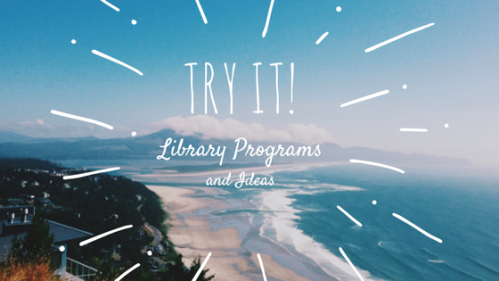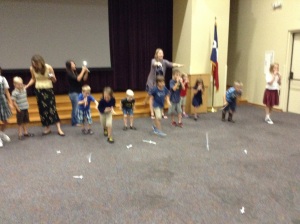
In October, we hosted our first STEAM program at the library. We scheduled the program for an hour and a half, taking the place of our regularly scheduled after-school craft program for the week. Our theme: space. Our mission: make learning about space fun and hands-on for each participant.

Program and Room Set Up
Based on our past attendance at our after school programs, we planned everything for 24 attendees. (This also worked out well in terms of dividing up supplies based on serving sizes and other considerations). Our program was held in our meeting room, which gave us access to enough space for several tables and chairs, as well as the projector and sound system. We set up a total of eight tables in a rectangle on one side of the room, with chairs only on the outside edges. The center we left open to give us (the librarians) space to move around, help the children, and demonstrate concepts as needed. The project screen is set up to display in the center of the room, and the other half of the room was left empty for our rocket launches later in the program.
We planned for a combination of technology, discussion, and hands-on learning. We planned three major segments to the program: moon craters, rockets, and comets. When we were setting up for the program, we did as much prep as possible ahead of time so that we didn’t have to do it during the program (I’ll give more specifics about each activity later in the post). At each place at the table, we put out any supplies that would be needed that were not sensitive to exposure. This gave the kids some visual clues about what we would be doing, and also kept us from having to run back and forth setting up materials during the program. Since part of program involved food, we prepped everything in the kitchen adjacent to our meeting room to be brought out when we were ready for the part of the program.
Program Introduction
We invited everyone into the room at once, and once everyone was seated around the table, we provided a brief introduction to the program. Originally, we had planned to just describe the afternoon’s activities, but my colleague had the great idea of asking the kids to guess what we might be doing with the materials that they had before them. We used those guesses to start our discussion about what we would be doing, and provided a few more details about the anticipated activities.
Interactive Technology: Solar System Scope
Since we were talking about space, we started out with a discussion of what we already knew about the stars and planets. Using our laptop and projector, we pulled up the Solar System Scope. We started out by learning some facts about the earth and the moon, and then took suggestions for other planets to explore. Rather than just delivering the information about each planet, we asked the kids what they knew about the planet or any questions they had. We threw out ideas about the different planets and then consulted the information on the website to learn more. I was actually surprised by how involved this portion was – almost every child present wanted to contribute information at some point or read facts from the website. We kept this going until we covered all the planets and interest waned.
Hands-On Activty: Moon Craters
Supplies:
- Salt map dough (pre-made at home and put into individual Ziploc baggies)
- Rocks (large and small, purchased in bags from Dollar Tree)
After looking at some pictures of moon craters, we talked a little about what would form them. We talked about different items that might find craters, and whether the distance or size of the object would impact the size of the crater. Then, each child got to make their own moon craters! We provided each child with an individual bag of salt map dough and a selection of rocks to drop and press to form the craters. We purchased two bags of rocks (one of large rocks and one of small rocks), and divided them up into plastic cups the day of the event so that everyone had a few. Some children made their own moons and planets by leaving the rocks in the dough, and some dropped or pressed rocks to make different shapes and craters. One thing I would do differently in the future with this part is NOT putting the salt map dough out ahead of time. Almost all of the children played with the dough in the bags during our introduction and discussion, so by the time they wanted to take it out, it was warmed up and very sticky. However, we did get a lot of positive feedback from parents for using the salt map dough since it has all-natural ingredients.
Video to Share: The Chemistry of Rockets
After moon craters, it was time to move on to our next component, rockets. Originally, we had planned to show this short video about how rockets work. However, since our salt map dough was a little messier than anticipated, we ended up dropping this activity in favor of a massive hand-washing expedition. We sent everyone out to wash their hands and cleaned up some of the biggest mess from the moon craters, and transitioned right into the next activity, instead.
Hands-On Activity: Straw Rocket Aeronautics
Supplies:
- Pencil (purchased in package of 12 from Walmart)
- Straw rocket template (printed on paper and pre-cut by teen volunteers)
- Straws (purchased in package of 100 from Walmart)
- Tape
Our next hands-on activity was creating our own rockets. We found this great soda straw rocket template from NASA that we used for this portion of the activity. The template includes all of the instructions, which was also a plus. Since we had extra volunteers for a different program a few weeks before this one, we had them cut out the rocket pieces ahead of time to save time. We gave each child the pieces he or she would need, and then talked about the steps to create the rocket. We assisted with the taping as necessary, and most of the parents also helped in putting the rockets together. After we created our rockets, we all lined up on the empty side of the room to launch our rockets and see whose would fly the farthest. I think everyone’s favorite part from this was yelling, “3, 2, 1, Blast Off!”

Video to Share: How to Catch a Star Stop Motion Short Film
We planned to break up our rockets and transition to comets with this short film by Oliver Jeffers. What we didn’t plan for was that rocket launching would be so exciting that we would have a hard time calming the kids back down for our next activity. So, we admitted that we probably weren’t going to keep their attention with this one, and instead transitioned into our final hands-on activity.
Hands-On Activity: Edible Comets
Supplies:
- Instant pudding (1 box for every four children, we purchased store brand)
- Milk (1 half gallon)
- Clear plastic cups
- Spoons
- Add-ins like cookies, chocolate chips, and sprinkles
Originally, we had planned to do ice cream comets for the final portion of the program. But, we decided that ice cream might be a little too involved, and we adapted to make pudding comets instead. If you divide the pudding from one box into four cups, and add 1/3 cup milk, it makes a single serving of pudding. Secret tip: Put the milk in the freezer for about 30 minutes, and it will be slightly slushy. This will let your pudding set up in 1-2 minutes instead of 5-10. We had the milk and pudding already separated out prior to the program, so all we had to do was bring out the ingredients.
We gave each child a cup of milk and a cup of pudding mix and instructed them to mix them together. We talked about the dust and debris that comets pick up, and then we added cookies that we crumbled, chocolate chips, and even sprinkles to represent our comets’ flight paths. When we had all the necessary ingredients, we stirred everything together and watched it solidify into pudding. The clear cups were great, because they let the kids see the entire transition from liquid to solid. Then we got to enjoy eating our creations!
Program Evaluation
Overall, this program was a great success. While we didn’t use all the elements that we planned for, the kids (and parents) had a great time and especially liked the hands-on components. We spent some time talking about our favorite parts after the program, and the parents did some socializing before leaving. I’m definitely glad that we did so much prep work ahead of time, because it made it so much easier to run the program. I do wish, though, that we had taken more pictures throughout the program to document what we were doing. Unfortunately, we were just too busy! But, several of the parents took pictures, so at least the families have some documentation from our program. The total cost for this ended up being about $1 per child, which was great. We let them take home their dough, rocks, and pencils if they wanted, and of course, everyone had a comet to eat, too. This was such a success that we are hoping to bring STEAM back again in January, with a snowman-themed program. I can’t wait to share about it, too!



